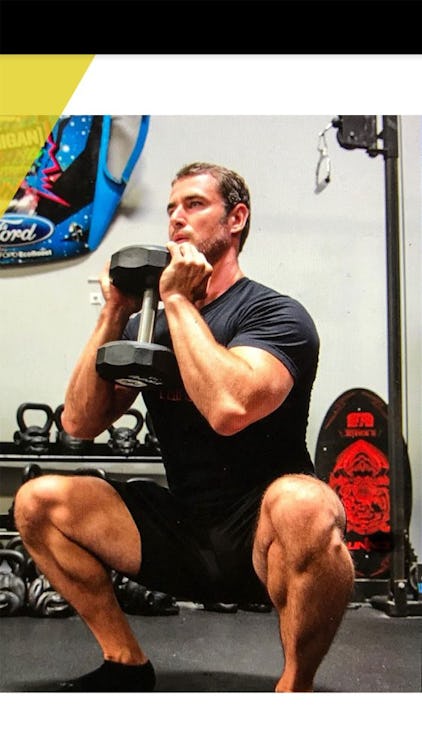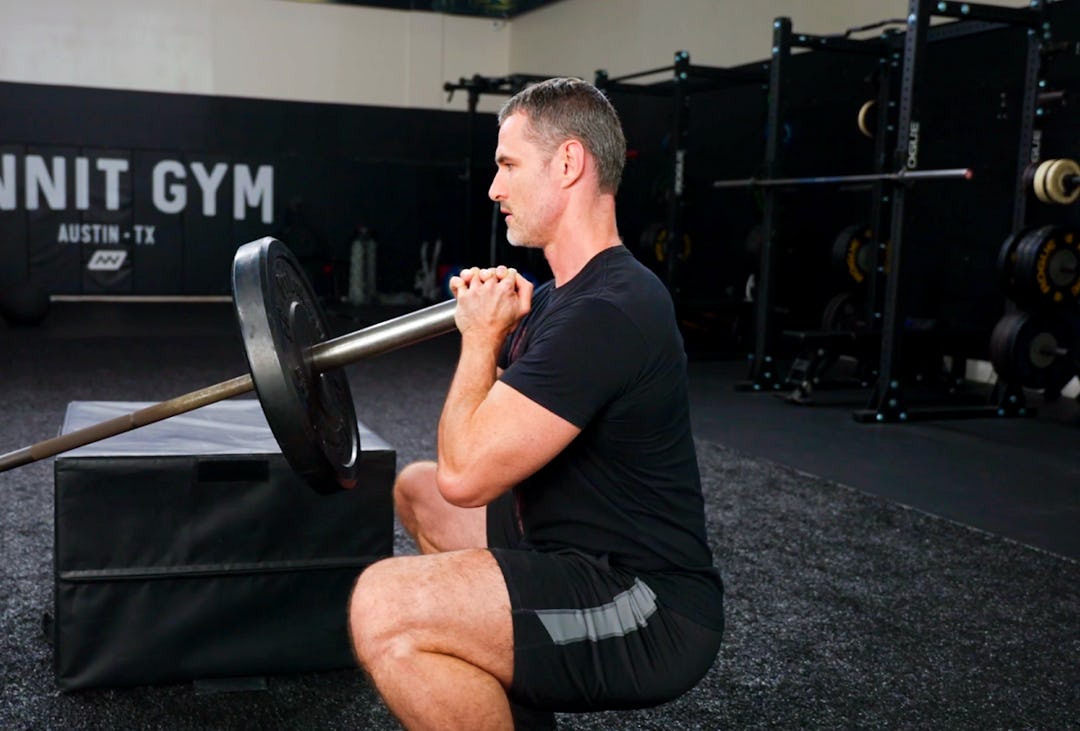You’ve heard the expression, “The squat is the king of all exercises,” and it usually refers to the barbell back squat. While that’s undeniably a great move for the legs, it’s not the only type of squat that will build up the thighs and give you a stronger, more explosive lower body. The landmine squat—where you load a barbell into a landmine unit and lift it like a lever in front of your body—is a very suitable substitute, and there are a few other squat variations that aren’t exactly court jesters either.
Let’s explore how to do the landmine squat for better squat technique, more quad development, and safer, user-friendly squatting in general.
What Is The Landmine Squat And What Are Its Benefits?
(See 00:35 in the video above.)
The landmine squat is done with the barbell in a landmine unit, which is a metal cylinder that swivels on an axis. A landmine allows you to lift the barbell in various arcing motions rather than straight up and down, letting you perform a number of exercises with a less complex squatting technique that can be easier on your joints.
In the landmine squat, the weight is held in front of your body rather than behind it, so landmine squatting resembles the front squat as well as the goblet squat that many people do with a kettlebell. Therefore, it’s sometimes called a landmine goblet squat. One big advantage of the landmine squat over the kettlebell goblet squat is that it’s more stable, and the barbell allows you to load more weight, so landmine squats in general can be done heavier and are usually a better choice for building muscle than the goblet squat.
Like the goblet squat, the landmine squat reinforces good squatting mechanics that keep you safe—for example, sitting your hips back and keeping your chest up as you descend. If you have trouble squatting with a barbell on your back—that is, if it bothers your low back or knees, or you just can’t seem to keep form—the landmine squat can be an awesome replacement exercise. Use it to ingrain good squatting mechanics, and then go back to the barbell back squat or front squat. You’ll probably find that your technique is sharper, and you can squat deeper than before.
How To Do The Landmine Squat?
(See 01:35 in the video.)
The landmine squat is pretty easy to perform, making it a great move for beginners, or other people who don’t have much experience squatting with load. You want the bar right up against your chest, and keep your torso as upright as possible as you squat down.
Step 1. Load a barbell into a landmine. If you don’t have a landmine unit, you can wedge the end of the bar into a corner in your gym. It won’t be quite as stable, but it should still work. Set a box or bench on the floor in front of the bar, right next to where the barbell plates will be loaded. Pick up the end of the bar and rest it on the box and load the plates you’ll use. Now you have a platform to lift the bar off, making it easier to get into position for the start of the exercise.
Step 2. Squat down in front of the bar and wrap your hands around the end of it. Tuck your elbows to your sides. Keeping your back straight and flat, lift the bar off the box and step away from the box if needed so it’s not in the way of your squat. You should end up standing with the bar right at your chest. (Don’t hold the bar any higher; that will make your shoulders work harder than they have to, and you’ll fatigue your upper body before your legs.)
Adjust your stance so your feet are between hip and shoulder width and your toes are turned out a few degrees. Now you’ll have to play around with your position and see what’s comfortable. You can lean forward so your weight is more on the balls of your feet, or you can stand tall—whatever allows you to squat with the deepest range of motion and good form.
Step 3. Draw your ribs down, take a deep breath into your belly, and brace your core. Keeping a long spine from your head to your tailbone, squat as deeply as you can, driving your knees apart so that they line up with your big toes. You should be able to go much lower than you normally could in a back squat without your heels rising off the floor or your lower back rounding.
Step 4. Extend your hips and knees to stand tall again. When you’ve finished your set, rest the weight on the box again.
What Muscles Does The Landmine Squat Work?
Like the back squat, you can count on the landmine squat to work the following muscles:
- Quadriceps (front thighs)
- Glutes (butt)
- Rectus abdominis, obliques (core)
- Various muscles of the upper back (they act as stabilizers here)
- Deltoids (shoulders, again, working to stabilize)
- Spinal erectors (lower back)
The landmine squat is a perfect choice for people who want to emphasize quad gains. Because the range of motion is so great at the knee joint (greater than a hip-dominant back squat), your quads will work hard throughout each rep. It’s also ideal if you suffer from lower-back pain during back squats. Your torso stays very vertical on a landmine squat, minimizing shear forces on the lumbar. In other words, landmine squatting lets you train legs heavy and hard without undue stress on the spine.
How To Do The Landmine Hack Squat
(See 03:34 in the video.)
The landmine can also be used as a substitute for the hack squat—the squat machine you see in most gyms where the weight is held behind the body and your back rests on a pad. The landmine hack squat may allow you to squat even deeper than the regular landmine squat, making it a great tool for emphasizing the quads. That said, it’s a little more awkward to set up and, for most people, will take some getting used to.
Step 1. Set up the barbell in a landmine as you did for the regular landmine squat. You don’t have to use a box to rest the bar on if you’re using light weights that you’re sure you can control, but if you do, make sure that when you squat, the bar will be clear of the platform. Wrap your hands around the bar and lift it up, turn around, and rest the bar on one shoulder.
Step 2. Play around with your foot position until you feel balanced and stable. Your feet should be between hip and shoulder-width apart and a little in front of you, and you should lean your bodyweight backward into the plate on the bar—that’s right, let the barbell support your weight just like a hack squat machine would. In this case, the bar really should be in a landmine unit. A corner alone may not provide the stability to support your body—so be smart and stay safe!
Step 3. Lower your body into the squat, going as deeply as you can without your pelvis tucking under and your lower back rounding. You should be able to get your knees almost fully flexed.
Step 4. Drive through the balls of your feet to stand back up. On your next set, switch the shoulder that the bar rests on so you don’t develop an imbalance.
How to Stretch Before Exercising
Use the following drills from Onnit-certified coach Eric Leija (@primal.swoledier) to warm up your hips and knees for strong squatting.
Landmine Squat Alternatives
(See 05:15 in the Landmine Squat video at the top.)
If you don’t have a landmine or a barbell, you can perform a goblet squat with either a kettlebell or a dumbbell. Like the landmine squat, the goblet squat is an excellent movement for learning and refining good squat technique, as it automatically forces you to squat with your chest up while driving your knees apart and sitting back into your hips.
Step 1. Hold a kettlebell in front of your chest by the sides of its handle. Draw your shoulders back and downward (think: “proud chest”), and tuck your elbows in close to the bell—try to get your forearms as vertical as you can. Stand with your feet between hip- and shoulder-width apart, and turn your toes out a bit—up to 30 degrees if you need to.
Step 2. Tuck your tailbone and draw your ribs down so that your pelvis is parallel to the floor. Take a deep breath into your belly, and brace your core. Actively twist your feet into the floor, but don’t let them move. Think of your legs as screwdrivers, or that you’re standing on grass and trying to twist it up beneath you. You should feel the arches in your feet rise and your glutes tighten, creating tension in the lower body.
Step 3. Keeping a long spine from your head to your pelvis, push your hips back and squat down, as if sitting down into a chair. Squat as low as you can while keeping your head, spine, and pelvis aligned. Push your knees apart as you descend. You should feel most of your weight on your heels to mid-foot area. If you feel your lower back beginning to round, stop there, and come back up. Keep your torso as vertical as possible—you shouldn’t have to lean forward or work extra hard to hold the bell upright. Avoid bending or twisting to either side.
Step 4. Drive through your feet as you extend your hips and knees to come up.


)






